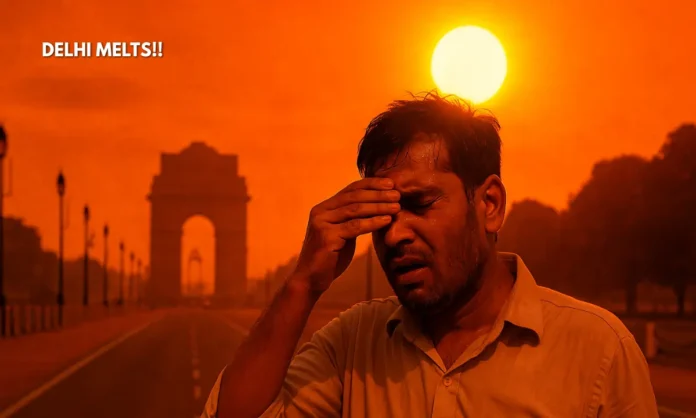Summary
- Delhi’s real-feel temperature peaked at 48.9°C on June 10, triggering a two-day orange alert from the IMD.
- The city recorded a maximum of 43.4°C with high humidity and warm nights, compounding health risks.
- Relief may arrive from June 12 with light showers and gusty winds, though humidity may rise thereafter.
Capital on the Boil: Delhi Faces Peak Heat Stress with No Immediate Respite
As the summer deepens, Delhi finds itself gripped by a brutal heatwave, with the real-feel temperature—also known as the heat index—soaring to 48.9°C on Monday, June 10. The India Meteorological Department (IMD) has issued an orange alert for June 11 and 12, warning residents to brace for continued harsh conditions and stay indoors during peak hours unless absolutely necessary.
The maximum temperature climbed to 43.4°C, significantly above the normal seasonal average, while humidity fluctuations between 48% and 25% made the heat feel even more oppressive. The situation is exacerbated by hot nights, as the mercury refused to drop below 27.6°C, offering little recovery time for the human body.
This is the second consecutive day of heatwave conditions in Delhi and surrounding regions like Hisar, Rohtak, and Sirsa, as confirmed by the IMD. For now, the capital remains firmly within the grip of what experts call one of the most intense urban heat episodes of the year.
#Heatwave #ClimateCrisis
— Weather Interpreter Tanny ⛈️🌤️ (@tan_5989) June 11, 2025
Incredible🤯
New Delhi crossed a Heat Index (Feel Like Temperature) of 50c to Record 50.1c at 2.30pm today🔥🥵@navdeepdahiya55 @shubhamtorres09 pic.twitter.com/gOgpIPiYLi
Sweltering Days and Sleepless Nights: The Meteorological Breakdown
- Daytime highs reached 43.4°C, with actual temperatures higher in satellite towns.
- Warm nights hovering near 28°C are adding to thermal stress.
- Humidity swings amplified the discomfort despite dry conditions.
- Winds of 20–30 kmph are expected but will offer minimal cooling.
- Heatwave conditions confirmed across Delhi, Haryana, and Chandigarh.
Delhi’s weather this June presents a textbook case of urban heat amplification, a phenomenon worsened by concrete-heavy infrastructure and minimal tree cover. The IMD forecasts high temperatures around 44°C until June 12, supported by dry, hot westerlies that fail to bring cooling rains.
Strong surface winds—ranging between 20 to 30 kmph—are predicted over the next 48 hours, but meteorologists say they will not significantly impact surface temperature or comfort levels. The urban heat island effect, wherein built-up areas retain more heat overnight, continues to drive high nocturnal temperatures, intensifying fatigue and increasing the risk of heatstroke, especially for vulnerable populations.
Heat Illness on the Rise: Who Is at Risk and What Comes Next?
- Elderly, young children, outdoor workers, and people with health issues face highest heat-related risk.
- High night temperatures hinder recovery, increasing hospital admissions for heat stress.
- IMD forecasts light showers and isolated thunderstorms starting June 12.
- Post-rain humidity may rise, causing sultry conditions even with lower temperatures.
- Air quality remains ‘poor’, with AQI at 235, compounding respiratory issues during heatwaves.
The biggest concern now is public health. Hospitals in the National Capital Region (NCR) are beginning to report a spike in heat exhaustion, dehydration, and related complications. Poor nighttime cooling significantly reduces the body’s ability to recuperate from daytime heat, a factor especially critical for Delhi’s elderly and chronically ill.
Some respite may come from June 12 onward, with light rainfall and gusty winds up to 40 kmph forecasted in parts of the city. However, officials warn that any relief may be short-lived and counteracted by rising humidity, which can trigger a different kind of discomfort—sultry, sticky evenings that further drain energy and patience.
Meanwhile, the Air Quality Index (AQI) stood at 235 (categorized as ‘poor’) on Monday, driven by dust, vehicular emissions, and low wind dispersal. Experts note that high temperatures can also aggravate pollution levels, leading to a double burden on health.
Monsoon Delay or Climate Disruption? Delhi’s Summer Now a Public Health Emergency
Delhi’s current heatwave is not an isolated event, but part of a larger climate shift sweeping across northern India. Cities in the Haryana–Delhi–Chandigarh subdivision are reporting consistently higher-than-normal temperatures and increasingly erratic rainfall patterns. Climate scientists have warned for years that heatwaves will become longer, more frequent, and deadlier.
The uncertainty surrounding the onset of the monsoon, combined with consistent urban sprawl and loss of green cover, has transformed Delhi’s heatwaves from weather phenomena into annual public health crises.
With temperatures near or exceeding 45°C, and both climate resilience and infrastructure preparedness still lacking, India’s capital needs more than just rain—it needs policy-level intervention, city-wide hydration infrastructure, real-time health alerts, and sustainable urban cooling strategies.


